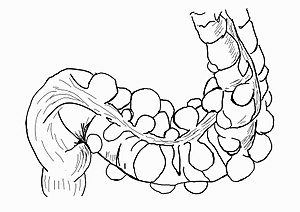Difference between revisions of "Partial colectomy for diverticular disease"
Jump to navigation
Jump to search
| (3 intermediate revisions by the same user not shown) | |||
| Line 1: | Line 1: | ||
[[Image:Sigmoid diverticulum (diagram).jpg|thumb|right|Drawing showing sigmoid diverticula. (WC/Anpol42)]] | |||
'''Partial colectomy for [[diverticular disease]]''' is a very common procedure. The sigmoid colon is typically afflicited; in that case it can more precisely be labeled '''sigmoidectomy for diverticular disease'''. | '''Partial colectomy for [[diverticular disease]]''' is a very common procedure. The sigmoid colon is typically afflicited; in that case it can more precisely be labeled '''sigmoidectomy for diverticular disease'''. | ||
==Introduction== | ==Introduction== | ||
This is | This is a relatively common specimen. [[Diverticulitis]] (inflammation of diverticula) and it complications are usually diagnosed by computed tomography (CT).<ref name=pmid27622365>{{Cite journal | last1 = Schultz | first1 = JK. | last2 = Yaqub | first2 = S. | last3 = Øresland | first3 = T. | title = Management of Diverticular Disease in Scandinavia. | journal = J Clin Gastroenterol | volume = 50 Suppl 1 | issue = | pages = S50-2 | month = Oct | year = 2016 | doi = 10.1097/MCG.0000000000000642 | PMID = 27622365 }}</ref> | ||
If the individual has a peritonitis, a (temporary) [[stoma]] is | If the individual has a peritonitis, a (temporary) [[stoma]] is created in a surgery known as a ''Hartmann's procedure''.<ref name=pmid27622365/> | ||
The pathologist's main tasks in this specimen is: | The pathologist's main tasks in this specimen is: | ||
#Confirming and documenting extent of the disease. | #Confirming and documenting extent of the disease. | ||
#Excluding malignancy. | #Excluding malignancy. | ||
==Protocol== | ==Protocol== | ||
Specimen: | Specimen: | ||
Latest revision as of 23:18, 9 October 2016
Partial colectomy for diverticular disease is a very common procedure. The sigmoid colon is typically afflicited; in that case it can more precisely be labeled sigmoidectomy for diverticular disease.
Introduction
This is a relatively common specimen. Diverticulitis (inflammation of diverticula) and it complications are usually diagnosed by computed tomography (CT).[1]
If the individual has a peritonitis, a (temporary) stoma is created in a surgery known as a Hartmann's procedure.[1]
The pathologist's main tasks in this specimen is:
- Confirming and documenting extent of the disease.
- Excluding malignancy.
Protocol
Specimen:
- Length __ cm.
- Circumference (proximal/one end) __ cm.
- Circumference (distal/other end) __ cm.
- Mesentry (maximal): __ cm.
Appearance:
- Serosal surface: [shiny/hemorrhagic/dull/exudate/adhesions].
- Mucosa: [unremarkable/granular].
- Polyps: [none/number - size __ cm, location (to nearest resection margin): __ cm].
- Number of diverticula (count up to 6, then estimate): [number of diverticula].
- Wall: [unremarkable/thickened].
Other:
- Perforation: [not identified/present - location of perforation (to nearest mucosal margin): __ cm, size of performation __ cm].
Representative sections submitted:
- Proximal mucosal margin.
- Distal mucosal margin.
- Diverticula (3-5 blocks).
- Interdiverticular mucosa (2 blocks).
- Lymph nodes (2 blocks).

